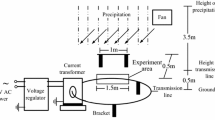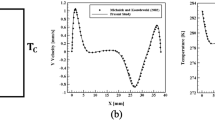Abstract
Icicles are often formed under the downside surface of conductor in the wet growth icing of overhead power line. When the ice deposit around overhead power line is molten by Joule heat produced by current, the pattern of heat transfer of ice deposit with icicles is dissimilar to that without icicle, so the ice-melting model for the columnar icing conductor cannot be applied to icicle-shaped icing conductor. According to the heat-transfer characteristic of the icicle-shaped icing conductor, this paper puts forward a DC ice-melting model for the icicle-shaped icing conductor. Because this full model includes three-dimensional heat-transfer and interface movement, which cannot be solved in closed form, a finite element scheme in space-domain and a finite difference scheme in time-domain are employed to discretize the governing equations. Firstly the whole ice-melting process on the icicle-shaped icing conductor is simulated by this model. Then the simulated results are validated by ice-melting experiments in the artificial chamber. The study from the model and the experiments shows that the size and length of icicle as well as the space between the adjacent icicles are factors to affect ice-melting. With the shorter icicle space, the bigger icicle size and the longer icicle-length, the surface of ice layer is enlarged and then more heat is taken away by the convection and radiation, so the ice melting time will get longer.
Similar content being viewed by others
References
Makkonen L. Modeling power line icing in freezing precipitation. Atm Res, 1998, 46: 131–142
Tang W B, Liu H Y, Li H J, et al. Experimental study of icing of contact wires in icing wind tunnels (in Chinese). East China Electric Power, 2009, 37: 250–252
Wang S H, Jiang X L, Sun C X. Study status of conductor galloping on transmission line (in Chinese). High Voltage Eng, 2005, 31: 11–14
Jiang X L, Fan S H, Zhang Z J, et al. Simulation and experimental investigation of DC ice-melting process on an iced conductor. IEEE Trans Power Delivery, 2010, 25: 919–929
Fan S H, Jiang X L, Sun C X, et al. Temperature characteristic of DC ice-melting conductor. Cold Regions Sci Technol, 2010, doi: 10.1016/j.coldergions. 2010. 02. 012.
Huneault M, Langheit C, Caron J. Combined models for glaze ice accretion and de-icing of current-carrying electrical conductors. IEEE Trans Power Delivery, 2005, 20: 1611–1616
Vargas J V C, Bejan A, Dobrovicescu A. The melting of an ice shell on a heated horizontal cylinder. Trans ASME. J Heat Transfer, 1994, 116: 702–708
Péter Z. Modeling and Simulation of the Ice Melting Process on a Current-Carrying Conductor. Université du Québec, 2006
Sadov S Yu, Shivakumar P N, Firsov D, et al. Mathematical model of ice melting on transmission lines. J Math Model Algor, 2007, 6: 273–286
Peter Z, Volat C, Farzaneh M, et al. Numerical investigations of a new thermal de-icing method for overhead conductors based on high current impulses. Iet Gen Transm Dist, 2008, 2: 666–675
Huneault M, Langheit C, Arnaud R S, et al. A dynamic programming methodology to develop de-icing strategies during ice storms by channeling load currents in transmission networks. IEEE Trans Power Delivery, 2005, 20: 1604–1610
Liu H Y. Ice accretion and ice shedding mechanism on overheat conductor (in Chinese). Doctoral Thesis. Wuhan: Huazhong University of Science and Technology, 2001
Horwill C. Davidson C C, Granger M. et al. An application of HVDC to the de-icing of transmission lines. 2005/2006 IEEE/PES Transmission and Distribution Conference and Exhibition, 2005
Gottlieb H P W. Exact solution of a Stefan problem in a nonhomogeneous cylinder. Appl Math Lett, 2002, 15: 167–172
Makkonen L, Fujii Y. Spacing of icicles. Cold Regions Sci Technol, 1993, 21: 317–322
John R. de Bruyn. On the formation of periodic arrays of icicles. Cold Regions Sci Technol, 1997, 25: 225–229
Farzaneh M. Atmospheric Icing of Power Networks. New York: Springer, 2008
Jiang X L, Fan S H, Hu J L, et al. Analysis on critical current of ice-melting with short-circuit DC for transmission line (in Chinese). Proc CSEE, 2009, 30: 111–116
Jiang X L, Yi H. Transmission Line’s Icing and Protection (in Chinese). Beijing: China Electric Power Press, 2001
Yang S M, Tao W Q. Heat Transfer (in Chinese). Beijing: Higher Education Press, 2006
Kong X Q. Application of Finite Element Analysis in Heat Transfer (in Chinese). Beijing: Science Press, 1998
Author information
Authors and Affiliations
Corresponding author
Rights and permissions
About this article
Cite this article
Fan, S., Jiang, X., Shu, L. et al. DC ice-melting model for wet-growth icing conductor and its experimental investigation. Sci. China Technol. Sci. 53, 3248–3257 (2010). https://doi.org/10.1007/s11431-010-4089-y
Received:
Accepted:
Published:
Issue Date:
DOI: https://doi.org/10.1007/s11431-010-4089-y




